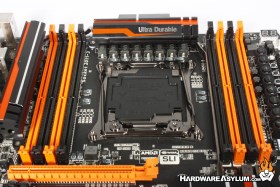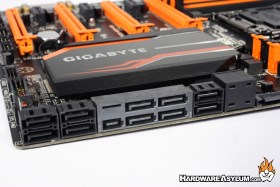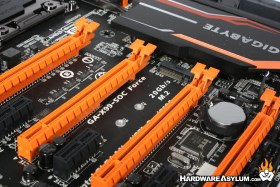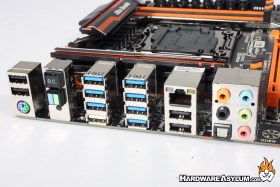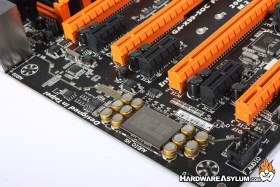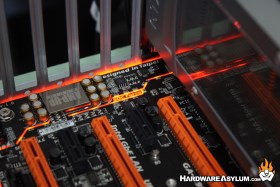Gigabyte X99 SOC Force Overclocking Motherboard Review
Author: Dennis GarciaBoard Layout and Features Continued
Quad channel memory comes standard on the Haswell-E processors and the X99 OC Force supports standard speed DDR4 modules at 2133Mhz with overclocking support beyond 3000Mhz. A maximum of 64GB is addressable however a 64-bit OS is required to use it all.
Internal SATA connections number ten and follow the new SATA6 connection standard. Two of the standard SATA6 ports are dedicated to SATA Express which is a new connection standard within the X99 chipset. You will also find two strange looking ports to the right of the SATA connections. Strangely enough these are K-Type thermocouple ports which are very common in the overclocking world for tracking subzero temperatures.
To compliment the new SATA Express connection on the edge of the motherboard you also get an internal Turbo M.2 socket for ultra compact SSDs with direct access to the PCI Express bus. These can deliver up to 20GB/s of bandwidth and are low profile enough to fit anywhere. You’ll find the M.2 between the middle most PCI Express slots and will accept both short and long boards. Keep in mind you can only use one, if the M.2 is populated then the SATA Express port is disabled.
Despite the overclocking nature of the X99 SOC Force there is still a full featured I/O panel available. You will find a single combined PS/2 keyboard and mouse plug, seven USB 3.0 ports (blue), four USB 2.0 ports (black) a single gigabit Ethernet connection, and 8 channel analog audio with digital connections over optical. The white USB port is a dedicated USB 1.1 connection for those pesky old devices that get confused by excess speed.
You will also find three buttons on the I/O panel the topmost is an OC switch for on the fly overclocking, followed by a BIOS switch for changing between the onboard BIOS chips. The last button is small because it will reset the CMOS in case of boot failure.
Many Gigabyte motherboards come equipped with the exclusive AMP-UP Audio solution which provides the industry’s highest level of onboard audio features and technologies. With Gigabyte AMP-UP Audio, gamers and audiophiles are able to experience crisp, ultra realistic sound effects while gaming, and the richest possible sound experience.
The chip used on the X99 SOC Force is the Realtek ALC1150 and comes with a build-in audio amplifier. The ALC1150 is a high-performance multi-channel High Definition Audio Codec that delivers an exceptional audio listening experience with up to 115dB SNR, ensuring users get the best possible audio quality from their PC. Simply put, it sounds great and is physically isolated from the rest of the motherboard to reduce any motherboard induced noise.
A nice feature that shows off the physical separation is orange backlighting that will illuminate the void in the PCB.

